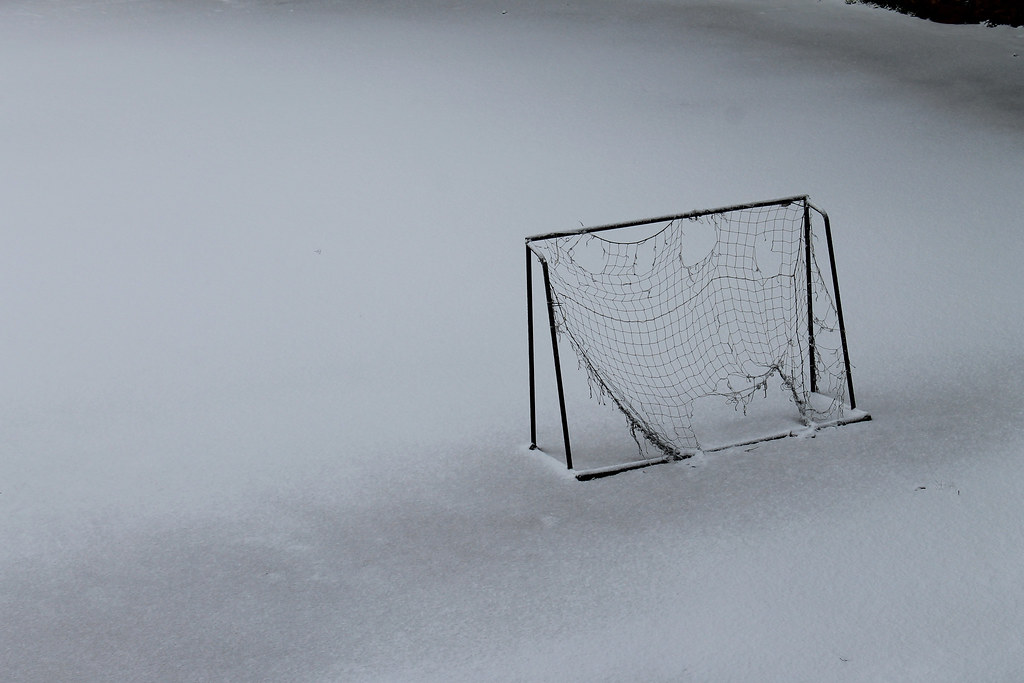Share the post "Why Do Soccer Players Wear Gloves? (Important!)"
Gloves are part and parcel of many sports, playing a key role in some of the most popular competitive disciplines such as boxing, American football, baseball, and motorsports to name just a few.
In soccer, we are accustomed to seeing goalkeepers wear specialized gloves for grip and protection when blocking shots and making saves. However, you may have noticed that it’s also quite common for outfield players to wear gloves.
For a sport that prohibits the use of the hands by anyone but the goalie, have you ever wondered why so many soccer players wear gloves?
Do soccer players enjoy accessorizing or are the gloves intended for a different purpose?
This article takes a look at the different types of gloves worn by soccer players and discusses the primary reasons for wearing them.

Reasons For Wearing Gloves
The main reason for outfield soccer players to wear gloves is to keep warm from the colder winter months, and the chill winds.
Most soccer games are played outdoors on large open fields, meaning there is little protection from the elements. Soccer players’ hands are continuously exposed and as extremities of the body, they are usually the first parts to get cold.
The human body is designed to regulate its temperature. During cold weather, the body increases blood flow to your vital organs and core to keep them warm.
The change in blood flow can restrict the amount of blood in your hands and feet, causing them to feel cold.
This is why professional soccer players, even when in full flight, may experience cold hands despite having a high overall temperature.
This also explains why you often see players wearing gloves with a short-sleeved jersey; something that would seem contradictory to most fans.
Some people are naturally more prone to having cold hands and feet. While this can be a sign of underlying illness, it is typically not the case, particularly in young and fit soccer players.
However, it may make players more inclined to wear gloves and other forms of protection during cold weather.

Importance of Staying Warm
In all sports, staying warm is crucial. Maintaining a high overall temperature prepares the body for physical activity and reduces the likelihood of sustaining a muscular injury.
One of, if not the most important pieces of preparation for soccer players and professional athletes is the warmup.
Warming up increases the temperature of the muscles and the body’s core. This ensures the muscles are loose and supple. During the warm-up, blood flow increases, sending oxygen and nutrients to the working muscles, readying them for demanding physical activity.
While gloves don’t directly prevent muscular injuries, they help reduce heat loss in the body, keeping players warmer for longer.
Former Chelsea striker, Tony Cascarino, recently criticized Arsenal players for wearing gloves:
“… they’re a soft team; a number of them, don’t get me wrong, wearing gloves – I think there were four Arsenal players who had gloves on.”
Tony Cascarino (2021)
Perhaps pundits should reconsider the importance of staying warm before lashing out at players for wearing gloves!
Risks of playing in the Cold
If players go into a training session or match without warming up, they are much likelier to develop a muscular injury. Cold-related muscle injuries can be anything from a minor strain to a full ligament tear.
According to a 2019 Forbes report, knee and hamstring injuries accounted for approximately half of the injuries in the Premier League, costing teams a staggering $111.5 million in rehabilitation.
This is why we see players and coaches putting so much time into the warm-up and warm-down routines. They not only help preserve players’ health and fitness levels, but they also reduce medical bills.
Using every available resource, including gloves and other warm clothing can help players to avoid getting cold, reducing their chances of injury.
Wearing Gloves For Climate, Asthetics & Commercial Reasons
Although warmth and injury prevention are the primary motivations behind soccer players wearing gloves, there are some other reasons worth considering.
Climate Adaptation
Many of the beautiful game’s sporting heroes hail from different parts of the globe. Brazil, Spain, France, and Portugal are known for producing some of the finest talents in world soccer.
These countries are also famous vacation destinations due to their spectacular weather.
Players who grew up playing soccer in warm climates may find it difficult to adjust to lower temperatures.
Imagine coming from searing African summers or the tropical climate of Rio De Janeiro to play all winter in the north of England.
It’s no wonder you see the likes of Riyad Mahrez (Algeria), Sergio Aguero (Argentia), and Paul Pogba (France) wearing gloves for winter games.
Commercial Opportunities
As the most-watched sport on the planet with over 3.5 billion fans worldwide, soccer players are the perfect advertising vehicles for sports brands.
Soccer continues to grow globally, with MLS audiences on ABC and ESPN networks increasing by 50% from the previous year in 2021.
Sponsored athletes may have special endorsement deals that enable them to make more money for wearing Nike or Adidas gloves during a game. Sponsors will jump at any opportunity to promote their brands.
Aesthetics
Many soccer players are known for their vanity. Gloves are some of the few items of clothing players can accessorize, making them a popular fashion choice.
Arsenal legend, Thierry Henry was known for breaking out his black Nike gloves and long-sleeved jersey throughout the winter months.
This look quickly became iconic, with some fans believing his cold-weather ritual brought out the best in their record goalscorer.
Goalkeeper Gloves
Before 1970, it was uncommon for goalkeepers to wear gloves.
Occasionally, in wet or extremely cold weather, goalies would wear a pair of leather, cotton, or woolen gloves to enhance grip. However, these were a far cry from what ‘keepers wear today.
While they offered increased grip and some element of protection, they soaked up moisture and water, causing numbness and discomfort.
Although there is no specific rule stating that goalies must wear them, gloves quickly became standard equipment as the technology behind them advanced.
With the speed of today’s game and the velocity at which players can shoot the ball, gloves are essential.
Best 3 Goalie Gloves
Product: Updated 2024-04-20 | Images: Amazon Product Advertising API | #ad - soccerblade.com is an Amazon Associate
There are hundreds, if not thousands of goalkeeper glove options. Some goalies prefer heavy padding and finger-saver style gloves, while others prefer lighter models that offer more finger dexterity.
Most goalkeepers own and use multiple pairs. They typically differentiate between training and gameday gloves.
Training gloves are usually thicker, with a dense palm to give them durability and longer life. However, the added thickness generally inhibits grip.
Gameday gloves are designed with thinner palm materials for better grip and dexterity. They are reserved specifically for games as the finer materials tend to wear out quickly.

Key Features of Goalkeeper Gloves
With such a wide variety of gloves available across a range of prices, it can be difficult to know which ones to go for. Three of the most important features of goalkeeper gloves are:
The Palm
The palm of the glove is the main component that affects a goalie’s grip.
Glove palms are manufactured using synthetic materials and usually contain a layer of latex, enabling keepers to hold on to powerful shots and pull crosses out of the air.
Most professionals wear gloves with smooth palms. As they are made using the highest quality materials, they offer the best grip. For cheaper gloves, the palms often contain textured patterns as they improve your handle and disperse water from the surface of the glove.
The Cut
The cut of the glove is essentially the shape and fit.
It’s important to choose the right cut to fit your hand, wrist, and fingers. If you have large hands and long fingers, you’ll likely need a different cut from someone with smaller hands and shorter fingers. Some ‘keepers prefer more support on the wrist while others opt for a looser fit and finger supports.
- A negative cut provides a tight fit for slender hands, giving goalies improved feel and ball control.
- Roll finger cuts attach the palm of the glove directly to its backhand, maximizing the latex contact area, enhancing grip. This cut doesn’t conform to the shape of the hand like others, making it more suitable for goalkeepers who enjoy a thicker glove with a looser fit.
- Flat cut gloves are designed for wide hands and feature gussets (strengthening materials sewn into the glove) on the exterior for extra support.
- Hybrid cuts combine features from other cuts to create a fully customized glove.
USA number 1, Matt Turner, wears custom-made Quantum Turner Pros, featuring a negative hybrid cut.
Manchester United veteran goalkeeper, David De Gea, wears Adidas Predator Pros that feature a negative cut with inward-facing seams to provide a tight fit and exceptional grip.
With the most all-time Premier League saves (946) of any active player in the league, perhaps the gloves do make a difference!
Finger Protection
Most modern gloves contain finger protectors. These are plastic inserts, placed into the backhand to protect the fingers from powerful shots and to prevent them from bending unnaturally.
Share the post "Why Do Soccer Players Wear Gloves? (Important!)"
Joel is a seasoned soccer journalist and analyst with many years of experience in the field. Joel specializes in game analysis, player profiles, transfer news, and has a keen eye for the tactical nuances of the game. He played at various levels in the game and coached teams - he is happy to share his insight with you.






